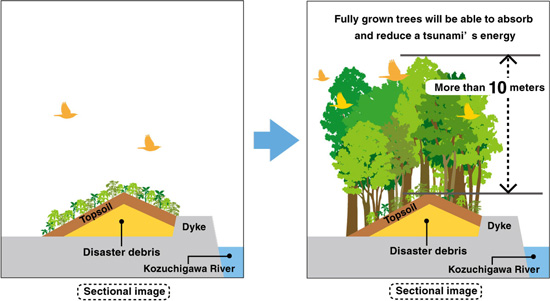News Release
Yokohama Rubber to Implement "Heisei Forest" Tree Planting in Otsuchi-cho, Iwate Prefecture
As Part of Activities to Support Restoration of Affected Areas
2013.May.07
- Management relation
- Sustainability relation
Tokyo - The Yokohama Rubber Co., Ltd., announced today that it will implement tree planting on May 18, in support of a plan to create "Forests That Protect Lives" set by Otsuchi-cho, Kamihei-gun, Iwate Prefecture as part of the town's recovery program. This is a part of Yokohama Rubber's activities to support restoration of the areas affected by the Great East Japan Earthquake. On April 30, 2012, the company carried out a first-phase model-forest tree planting in Otsuchi-cho under its Yokohama Forever Forest Project. Starting with the second-phase event of this year, the model forest is to be called "Heisei Forest."
Since the first-phase tree planting, Yokohama Rubber has engaged in continuous support activities toward second-phase planting and beyond, including gathering the seeds of broad-leaved trees indigenous to the local area, growing seedlings together with the residents of the town, gathering rice straw, etc. For the second-phase tree planting of this year, a new 50-meter mound will be created adjacent to the 50-meter mound where seedlings were planted last year, on the premises of the Otsuchi Purification Center, and approximately 5,000 seedlings of broad-leaved evergreen trees indigenous to the area will be planted. On May 18, Otsuchi-cho Mayor Yutaka Ikarigawa, local residents, representatives of supporting companies and others including former F1 driver Mr. Ukyo Katayama will participate in the event. From Yokohama Rubber, Chairman and CEO Tadanobu Nagumo and President Hikomitsu Noji will take part, and employee volunteers will advise participants on how to plant the trees and join them in the process.
A characteristic feature of Otsuchi-cho's "Forests That Protect Lives" is efficient use of disaster debris in the tree planting - woody debris, earth and sand and non-combustible earthy debris such as concrete pieces from the disaster. Use of disaster debris not only helps reduce the cost of its disposal and CO2 emissions from incineration, but will actually facilitate the growth of the seedlings.
The Yokohama Rubber Group has been carrying out the Yokohama Forever Forest Project since 2007, largely on the initiative of its employees, under the guidance of Dr. Akira Miyawaki, plant ecologist and professor emeritus of Yokohama National University. Conceived by him, "Forests That Protect Lives" is an effort to create "genuine" or "native" forests that will withstand tsunami along the 300-kilometer Pacific coast in the Tohoku region. Dr. Miyawaki advocates effective use of disaster debris in mounds created for planting.
Drawing of "Forests That Protect Lives"




